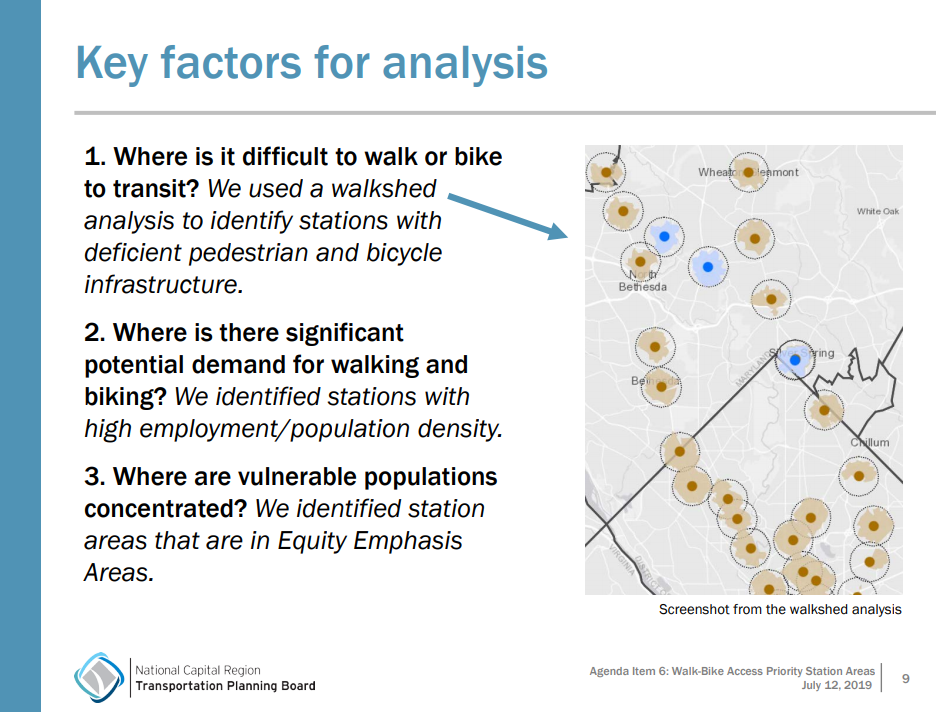This is the second in our two-part series about making it easier for people to walk and bike to transit. Read part one explaining walksheds here.
Better paths for walking and biking are important everywhere. But where should we consider such improvements to be regional priorities? Walking and biking improvements clearly take on regional significance when they have the potential to put transit within reach for more people.
The TPB enshrined this principle in the region’s new long-range transportation plan, Visualize 2045, which identified pedestrian and bicycle access to transit as one the plan’s seven aspirational initiatives. Now, regional planners are adding some geographic specificity to that conceptual declaration.
Read more about the Visualize 2045 aspirational initiatives.
TPB staff are currently working to identify a limited list of locations that will be regionally prioritized for improving walking and biking connections to trains and express bus stations. These locations will be places with significant opportunity to improve walk and bike access to transit.
Why is this important for regional planning?
There are still too many station areas in our region where people drive to transit. In many cases, walking or biking is too time-consuming, too unpleasant, or too unsafe. It is regionally significant to consider investing in remedies to these conditions because they will not simply help people get around locally but will also improve access to regional transit systems.
Out of the large collection of high-capacity transit stations (Metrorail, commuter rail, streetcar, bus rapid transit, and light rail) in the region, the TPB has determined it will be helpful to identify a focused number of transit station areas where pedestrian and bicycle improvements could have a particularly significant impact on mobility and access to transit. These are places with critical gaps and significant opportunities to increase walking and biking to transit. New pedestrian and bicycle facilities are particularly key for providing first- and last-mile connections to high-capacity transit.
In the big picture of regional planning, it makes sense to focus on the strategy of improving non-motorized access to high capacity transit. These efforts help to reduce vehicular trips by making walking and biking more viable. They help to increase the return on our regional transit investments by increasing use of the system. And they help to bridge the connection between land use and transportation planning by serving existing and latent demand.
The TPB expects that the list of high-priority station areas staff is working to identify through this effort will receive priority consideration for funding by the TPB’s member jurisdictions and agencies. In addition, projects at these station areas will receive priority consideration for funding through the Transportation Land-Use Connections (TLC) Program, grant funding from the Transportation Alternatives Set-Aside Program (TAP), and other potential funding opportunities. The ultimate goal for this project is for local jurisdictions and states to use the priority designations to support efforts to seek funding in capital programs and/or from developers or other sources.
TPB staff has spent the last few months developing a preliminary list of priority station areas based upon three key criteria to develop the list, staff developed a composite score for each station. Using those composite scores, the stations with the highest scores in each jurisdiction were flagged for inclusion on the list.

This work will provide the basis for discussions with the individual TPB member jurisdictions. These discussions will compare the stations that have been preliminarily flagged with each jurisdiction’s priorities and the realities on the ground.
TPB Staff plans to meet with the individual jurisdictions this fall. These meetings will provide feedback and guidance for staff to adjust the list of priority station areas. Once this work is completed, a list will be publicly released. The TPB is expected to vote on the list early in 2020.
John Swanson, Nicole McCall, and Charlene Howard wrote and contributed to this article.